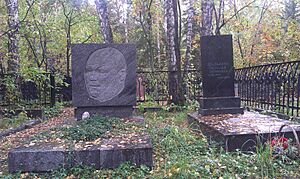Anatoly Maltsev facts for kids
Anatoly Ivanovich Maltsev was a very important Russian mathematician. He was born near Moscow in 1909 and passed away in Novosibirsk in 1967. He is famous for his work on different types of math problems, especially those about "algebraic groups." Some special math ideas, like "Malcev algebras," are even named after him!
His Life and Studies
Anatoly Maltsev was great at math from a young age. After finishing school in 1927, he went to Moscow State University to study mathematics. While he was a student, he also started teaching at a high school in Moscow.
After he graduated in 1931, he kept teaching. In 1932, he became an assistant at the Ivanovo Pedagogical Institute. This institute was located in a city called Ivanovo, not far from Moscow.
While teaching in Ivanovo, Maltsev often traveled to Moscow. He would meet with a famous mathematician named Kolmogorov to talk about his research. Maltsev's first published works were about logic and "model theory." Soon, Kolmogorov invited him to join his special graduate program at Moscow State University. Maltsev kept his job in Ivanovo but also became Kolmogorov's student.
In 1937, Maltsev published a paper about how to "embed" one type of math structure, called a ring, into another, called a field. Two years later, he published another paper. In this one, he explained the exact conditions needed for a "semigroup" to be embedded into a group.
Between 1939 and 1941, he worked on his advanced doctorate degree. He studied at the Steklov Institute of the USSR Academy of Sciences. His main project was about the "Structure of isomorphic representable infinite algebras and groups."
Professor and Researcher
In 1944, Maltsev became a professor at the Ivanovo Pedagogical Institute. He continued to work on group theory, especially "linear groups." He also studied "Lie groups" and "topological algebras." He made a special connection between Lie groups and Lie algebras, which is now known as the Mal'cev correspondence.
In 1958, Maltsev became a full member, or "Academician," of the Soviet Academy of Sciences. This was a very high honor.
In 1960, he moved to Novosibirsk. He was given a special position in mathematics at the Mathematics Institute there. He also became the head of the Algebra and Logic Department at Novosibirsk State University.
Maltsev did many important things in Novosibirsk. He helped start the Siberian section of the Mathematics Institute. He also founded the Siberian Mathematical Society and a math journal called Algebra i Logika.
He also started a special meeting group called the "Algebra and Logic Seminar." His students and other mathematicians attended this seminar. This group helped create a new and very successful way of thinking about "model theory" and "decidability."
In the early 1960s, Maltsev worked on problems about the "decidability" of different algebraic structures. He showed that some of these structures were "undecidable." This means there's no general way to figure out if a statement about them is true or false using a step-by-step process. He also proved that a certain type of algebra, called "locally free algebras," did have a decidable theory.
Anatoly Maltsev received many awards for his amazing work. He won the State Stalin Prize in 1946 and the Lenin Prize in 1964.
See also
- Hahn–Mal'cev–Neumann series
- Malcev algebra
- Mal'cev's criterion
- Malcev Lie algebra
- Malcev-admissible algebra


